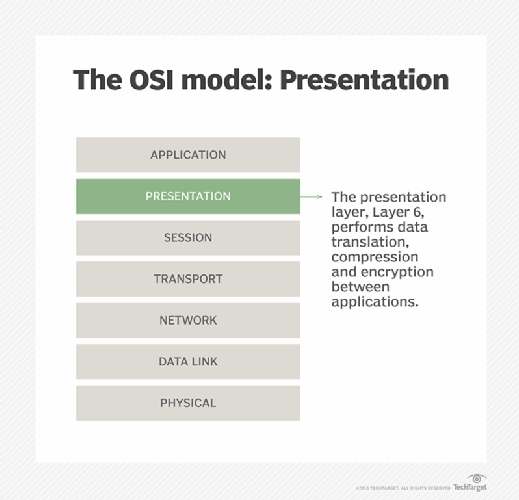What is the presentation layer?
The presentation layer resides at Layer 6 of the Open Systems Interconnection (OSI) communications model and ensures all communications that pass through it are in the appropriate form for the recipient application. In other words, the presentation layer presents data in a readable format from an application layer perspective.
For example, a presentation layer program could format a file transfer request in binary code to ensure a successful transfer. Binary is the most rudimentary computing language. It ensures the receiving device can decipher and translate it into a format the application layer understands and expects.
How the presentation layer works
The presentation layer ensures proper formatting and delivery to and from the application layer. Once the application layer passes data meant for transport to another device in a certain format, the presentation layer prepares this data in the most appropriate format the receiving application can understand.
Common data formats include the following:
- American Standard Code for Information Interchange (ASCII) and Extended Binary Coded Decimal Interchange Code (EBCDIC) for text.
- Joint Photographic Experts Group (JPEG), Graphic Interchange Format (GIF) and TIFF for images.
- Moving Picture Experts Group (MPEG), Musical Instrument Digital Interface (MIDI) and QuickTime for video.
The presentation layer also performs data encryption and decryption. Here, encryption methods and keys exchange between two communicating devices. Only the sender and receiver can properly encode and decode data so that it returns to a readable format.
The presentation layer also manages the serialization of data objects. It can serialize -- or translate -- more complex application data objects into a storable and transportable format. This helps rebuild the object once it arrives at the other side of the communications stream. The presentation layer also deserializes the data stream and places it back into an object format that the application can understand.
Another function of the application layer is data compression and decompression. This process helps reduce bandwidth consumption and increase transmission speeds.

HTTP example
Although HTTP is technically considered an application-layer protocol per the TCP/IP model, it includes presentation layer services within it. The tool that manages HTTP is an example of a program that loosely adheres to the OSI presentation layer.
HTTP works when the requesting device forwards user requests passed to the web browser onto a web server elsewhere in the network. It then receives a return message from the web server including a Multipurpose Internet Mail Extensions (MIME) header. The MIME header indicates the file type -- text, video or audio -- that it received so an appropriate player utility can present the file to the user.








